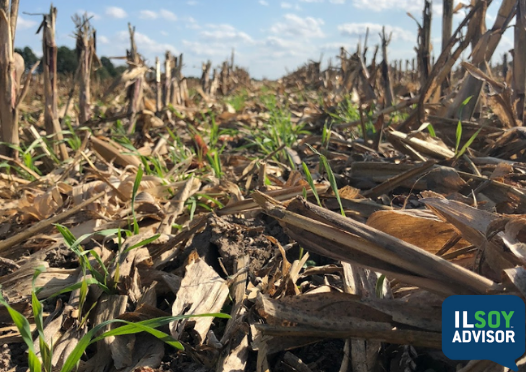ILSOYADVISOR POST
New research results provide more cover crop recommendations
Updated from the 2019 edition and expanded to 16 pages, the new Guide encourages adopters to think a “systems” approach when it comes to cover crops as an integral part of a total crop rotation system. Cover crops should be considered to help reduce nutrient losses through tile drainage.
Researchers from the University of Illinois, Illinois State University, Southern Illinois University, and Purdue University have been studying the various variables involved in a successful cover crop program. Research efforts are supported by Dan Schaefer with Illinois Fertilizer and Chemical Association (IFCA) and Eric Miller, a Piatt County farmer, who has been incorporating cover crops into his production strategies for a number of years.
Research has been conducted at the field-level scale on farms in 15 Illinois counties – north to south – to achieve balanced and geographic recommendations. Each researcher is challenged to discover how cover crops can scavenge nitrogen and lower the level of N in field tiles, while not compromising yield or impacting profitability. Most research is focused on cereal rye as the chosen cover crop ahead of soybeans.
In detail, the Guide describes options for planting cover crops, including an innovative technique for seeding while harvesting. Farmers can mount an air seeder to their corn head. Seed is dispersed while corn is being harvested, saving time and money.

An air seeder is attached to the corn head. Cereal rye seed is blown from the seed hopper through individual hoses mounted under each row snout and scattered before corn residue is deposited.

Seeding rates of cereal rye have been updated from previous editions of the Guide. A new NREC-funded project at Western Illinois University is just getting underway that examines cover crops in a grazing environment.

Terminating cover crops is the next natural step for utilizing cover crops and several examples on when and how are covered in the document. The participating researchers all agreed that the establishment of the soybean crop always takes priority over attempting to reach a specific cereal rye growth stage. Researchers have determined that the ideal cereal rye biomass range ahead of no-till soybeans should be 0.5 to 2.5 tons/acre. Weed suppression attained with cover crops partially offsets the extra costs associated with cover crops by eliminating one herbicide application.
Two full pages of the Guide are dedicated to planting soybeans following cereal rye. Again, NREC’s researchers stress that planning cover crops as part of the “system” is important, and that growers should plan fall tillage in advance. Several scenarios work well and farmers are cautioned that if they are trying one of the investigated practices, that they pay particular attention to planter settings appropriate for their respective field conditions.
Consistently, researchers have shown that cover crops, over time, really do reduce nutrient losses. For instance, in McLean County, data demonstrates the effect of cereal rye cover crop in reducing nitrate concentrates by at least 30%. Studies were compared between a single field and one from a paired watershed.

McLean County Cover Crop Study
In a replicated tile drainage study in Douglas County, the data shows the beneficial carryover effect of the cover crop on tile nitrate concentrations through the next tile drainage season.

Finally, cover crops work best in a production system that utilizes strip-till and no-till in a conventional corn/soybean rotation system. Farmers are encouraged to think in terms of a total system.
A copy of the NREC Cover Crop Guide can be downloaded from the website under Resources at www.illinois.nrec.org or printed copies can be requested by completing the form at https://forms.gle/FoAUuhrx7PT54Ube7 or by emailing Julie@illinoisnrec.org.





Comments
Add new comment